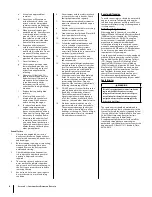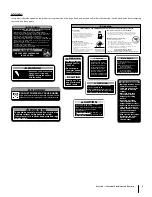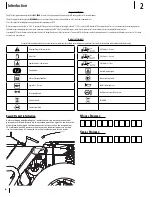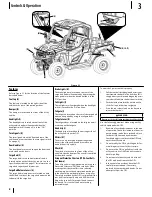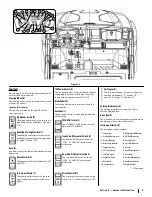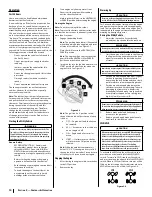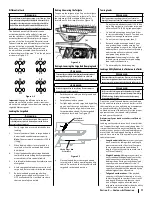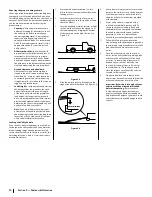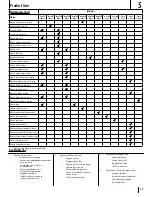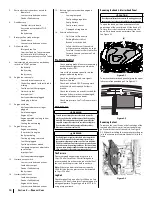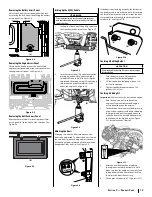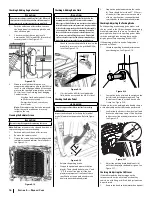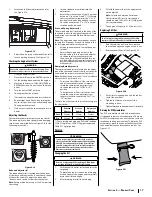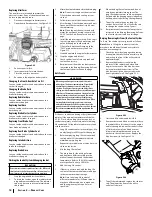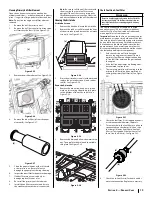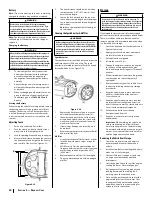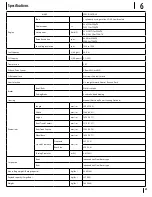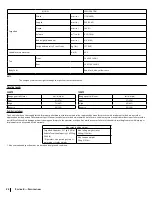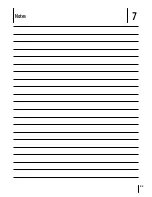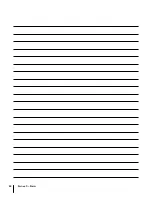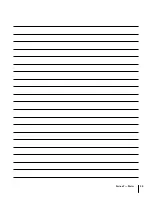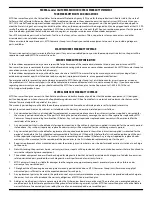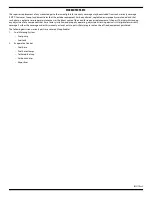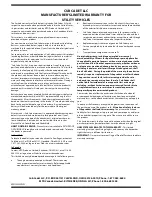
17
S
ection
5 — P
roduct
c
are
2.
Locate the shift lever adjustment nuts (a).
See Figure 5-18.
(a)
Figure 5-18
3.
Adjust the nuts (a) up or down until the shift
lever is working properly. See Figure 5-18.
Checking the Engine Start System
WARNING
Do not allow anyone near the vehicle while testing. If the
vehicle does not pass the test, do not operate the vehicle.
1.
Sit on the operator’s seat.
2.
Place the shift lever in the NEUTRAL position.
3.
Set the parking brake and stop the engine.
4.
Move the shift lever to: LOW, HIGH, PARK or
REVERSE position. Do not step on the brake
pedal.
5.
Turn the key to START position.
6.
The engine should not crank.
7.
If it cranks see an authorized service dealer.
8.
Repeat steps 4 and 5 but when turning the
key to start position step on the brake pedal.
The engine should crank.
9.
If it does not crank see an authorized service
dealer.
Adjusting the Shocks
There are three adjustment points on the shocks.
The rebound (a), pre-load spring (b) and damping
rate (c) can be adjusted. Refer to Figure 5-19 for the
following instructions.
C
Fa
st
Slo
w
F
S
(a)
(b)
(c)
Figure 5-19
Rebound Adjuster (a)
The rebound adjuster is located near the bottom
of the shock and controls the “bounce back” speed
of the utility vehicle. To adjust the rebound or
“bounce-back” speed, follow the steps below:
Note:
Each position has a stop or “click” to indicate
the setting.
1.
Insert a standard screw driver into the
adjustment.
2.
Rotate the screw into one of the 18 positions
between “S” (position 0) and “F” (18). Rotate
the screw clockwise (towards the “S” or “0”
position) to slow the rebound and counter-
clockwise (towards the “F” or “18” position)
to speed up the rebound.
Pre-Load Spring Adjuster (b)
The pre-load adjuster is located in the body of the
shock and controls the height of the vehicle. It can
be adjusted to accommodate for different load
situations.
Note:
This adjustment requires a spanner wrench
to complete. A spanner wrench is included in the
tool kit shipped with this utility vehicle.
1.
Using a spanner wrench, loosen the upper
lock nut.
2.
Adjust the pre-load adjuster nut to the
desired setting. Turn the pre-load adjuster
clockwise to increase the compression
force (raise the utility vehicle) and turn the
pre-load adjuster nut counter-clockwise to
decrease the compression force (lower the
utility vehicle).
Damping Rate Adjuster (c)
The compression adjuster is located on the upper
part of the shock and controls the ride of the utility
vehicle and the impact resistance of the shocks.
Note:
Each position has a stop or “click” to indicate
which of the 18 positions it is in.
1.
To increase the stiffness of the suspension
and increase the absorption of impacts,
rotate the compression adjuster screw
clockwise towards the “SLOW” (or “0”)
position.
2.
To decrease the stiffness (soften the ride)
rotate the compression adjuster screw
counter-clockwise towards the “FAST” (or
“18”) position.
To return the utility vehicle to its stock setting, use
the chart below:
Rebound
Adjuster
Pre-Load
Adjuster
Compression
Adjuster
Front
Position 7
295 mm
Position 5
Rear
Position 4
300 mm
Position 3
* -- These setting are based on a “full load” condition.
250 lb (113 kg) driver, 250 lb (113 kg) passenger and
500 lb (227 kg) cargo load.
Service
WARNING
To avoid personal injury, be sure to check and service the
vehicle on a flat surface with the engine off and the parking
brake ON. If servicing under the cargo bed, be sure that the
cargo bed is supported so that it can not inadvertently close.
Do not touch muffler or exhaust pipes while they are hot;
Otherwise, severe burns could result.
Changing the Oil
WARNING
Be sure to stop the engine before replacing oil. Allow engine
to cool down sufficiently, oil can be hot and can burn.
1.
Park the vehicle on flat surface and raise the
cargo bed.
2.
To drain the used oil, remove the drain plug
at the bottom of the engine and completely
drain the oil into an oil pan.
3.
After draining, reinstall the drain plug.
4.
Fill with the new oil up to the upper notch
on the dipstick.
Note:
Oil with an American Petroleum
Classification (API) service classification
should be used. 10W/40SL, JASO-MA grade
oil is recommended.
5.
The engine oil capacity is 2.22 quarts (2.1L)
Replacing Oil Filter
WARNING
Be sure to stop the engine before replacing oil filter. Allow
engine to cool down sufficiently, oil can be hot and can burn.
1.
Park the vehicle on a flat surface, remove
the seat and open the engine access cover.
2.
Remove the oil filter (a). See Figure 5-20.
(a)
Figure 5-20
3.
Put a film of clean engine oil on the rubber
seal of the new filter.
4.
Tighten the filter until it contacts the
mounting surface.
5.
Tighten filter by hand an additional 1/2-turn only.
Draining the PCV Accumulator
The PCV accumulator should be drained at each
oil changed to remove oil condensation. There are
two PCV accumulators, one near the front of the air
intake box and one near the rear. To drain the PCV
accumulator, pinch the valve at the bottom of the
tube and allow the condensation to run out. See
Figure 5-21.
Figure 5-21


